2.3 Tiles
Although you can draw an entire image on screen at once (many DS games are great fans of this and effectively make a tile 256 wide by 192 high necessitating a tile editor capable of handling it, a trick which many legacy ones are not able to) most 2d graphics are built from small building blocks known as tiles. Typically these tiles are 8 by 8 or 16 by 16 pixels although text fonts and 3d textures as well as the previously mentioned “full screen tiles” like to break from form here. The simple way to think about them is to think of them as very boring (thanks to the square pixels) versions of a paint by numbers picture with the numbers being looked up from a palette. Although most people never have to touch the graphics themselves with a hex editor an appreciation of how the hardware works is necessary to reverse engineer some of the more complex formats. Likewise to gain an appreciation for the animation/handling mechanisms learning about the methods by which tiles and palettes for them operate is all but mandatory.
2.3.1 1Bpp
Technically it is a compression method (the screen/video hardware itself does not display the mode in any real sense) but it is a special case as it is so simple that a basic tile editor can handle it and it can be edited in place without issue as indeed Crystaltile2 does, to that end it is here rather than later on when compression is discussed. The idea being if you have a black and white font or some other two colour image each four bits, the minimum length for a pixel the hardware accepts, will in fact be one or the other allowing you to compress the image down into 1 bit per pixel. Although it is not mandatory for developers to use it when dealing with 1bpp imagery the GBA and DS BIOS actually carry a “decompression” method in SWI10h that is known as BitUnPack.
2.3.2 4 Bpp
The workhorse of the GBA and a good chunk of the DS. Bringing back the icon from Yakuman DS. The “marching ants” selection is the section viewed in the hex editor which is as it is in the original ROM (certain hex editors can flip nibbles but it was not done here). As you can see each nibble looks up the value of a single colour (one of 16) which can be anything in the 15 bit format the GBA and DS can use. Equally there are 32 palettes each with the option for 16 colours which the game can swap between at runtime. Although not the only colour animation possible (the palette can also be edited at runtime) a developer can use these multiple palettes to change the appearance of items within the game and if you see the option to change at say the start of a battle (advance wars war room is good for this) or indeed at runtime then you are almost certainly looking at this.
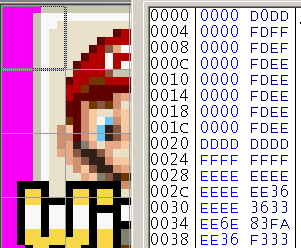
PIC
Palette

PIC
As you can imagine the background is not pink in the real game and this is as the first colour in a palette is treated as though it was transparent regardless of what it is (although in practice is is fairly pointless with the way the screen works it allows for a full colour range without the loss of a single colour).
2.3.3 8Bpp
Although available and well used on the GBA it really started to be used on the DS.
Here each palette entry is 8 bits long and a two 256 colour palettes are available although only one for each mode (BG and OAM)
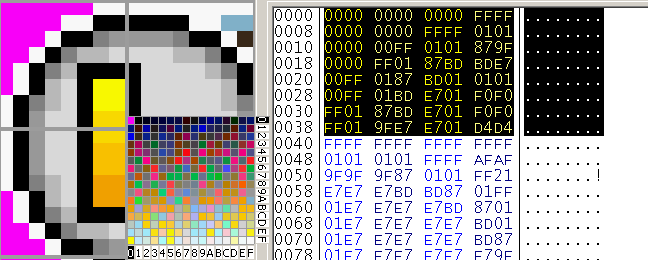
PIC
Here each hex digit is the lookup for the palette with the first being the row and the second being the column (although if you really wanted you could flip them and indeed the hardware probably does effectively just that but that is introducing completely unnecessary work for no real gain).
2.3.4 GBA3 Xbpp
There is another method that much like 1Bpp acts as a sort of compression meets hardware format method. Crystaltile2 is one of the few editors with support for this method and it is very rare indeed (the very occasional font being about the only thing that uses it).
It is a kind of 4 colour format (2 bits per pixel) but values are actually interleaved between two consecutive tiles.
Nibbles are “flipped” similar to the 4bpp GBA format. The order of the nibbles is then lower tile, upper tile, lower tile, upper tile……
A basic example of the interleaved format 8x8 tiles (larger tiles of this pretty much follows the same pattern but to spare confusion it will not be covered here).
Palette as defined in the image. Remember the nibbles are actually flipped but ignoring that for the moment
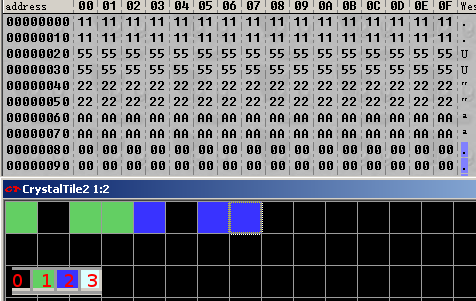
PIC
The first pair of tiles is one fully green (01 binary on the palette) and one fully black (00 binary)
The second pair of tiles is both fully green (01 binary on the palette)
All this being said it is 4 bits between the start of a pixel in a given tile and the start of the next pixel in the tile which gives rise to the numbers seen
1 hexadecimal is 0001 binary hence the 00 going to the second (lower) tile and 01 going to the first (upper) tile.
The second pair is both green and is represented by 5 hex
5 hex corresponds to 0101 binary
The pattern still holds for the single blue and single black tile
The dual blue tiles
A hex corresponds to 1010 binary.
A more complex example Most of this is going to be left as an exercise to the reader but as mentioned the nibbles are flipped in a similar manner to 4bpp and it is not immediately apparent in the above example.
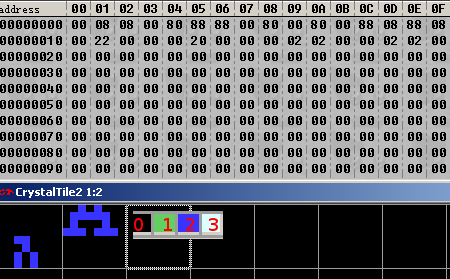
PIC
The leftmost (upper) tile is blank for 4 vertical pixels but the lower tile has data in it.
00 08 08 00 hex
0000 0000 0000 1000 0000 1000 0000 0000 binary
80 88 88 00 hex
1000 0000 1000 1000 1000 1000 0000 0000 binary
The first pixel is blank on both counts as is the second so the 00 holds.
The third is not blank yet it is still 00, the fourth is blank but it is 10 (10 binary = 3 remember). As mentioned the nibbles are flipped with respect to the pixels they represent.
The fifth pixel is blue but it is 00 and the sixth pixel is 10 (again flipped).
Going to the next line
Blank and then blue. Flipped again (10 and 00 being seen in the binary).
2.3.5 GBA2 4BPP
For the sake of completeness crystaltile2 has another format known as GBA2 4bpp that is in some ways slightly more complex than GBA3 XBPP. Very few games have ever been observed to use it either.
It is a 4bpp format and technically is not nibble flipped like the other sub 8 bit formats but in practice it is a kind of interpolated format (each pixel technically having a choice of four colours) and additionally the first pixel in the pair of them sets the colour range for the second one.
The range in question is value 0-3, 4-7, 8-B and C-F. They could up so 0 through 3 allows the first four pixels (selection 0), 4 through 7 allows the second four pixels (selection 1) and so on but some more background is needed before that makes sense.
The first nibble selects from the first four colours using the range (0 through 3 pixel 0, 4 through 7 pixel 1 and so on)
The second nibble selects from one of four colours also in a row but what four it can select from is determined by the value of the first nibble. Within the values although it might not matter for the first pixel the second one has the four pixels also in a range of four and those are selected by the actual value within first pixel.
Examples
Selection 0 value 2 (in practice it would be 2 hex for the first pixel) allows the third group of colours from the palette for the second pixel.
Selection 3 value 2 (in practice it would be E hex for the first pixel) allows the third group of colours from the palette for the second pixel.
Selection 0 value 0 (in practice it would be 0 hex for the first pixel) allows the first group of colours from the palette for the second pixel (0 through 3 in the standard numbering).
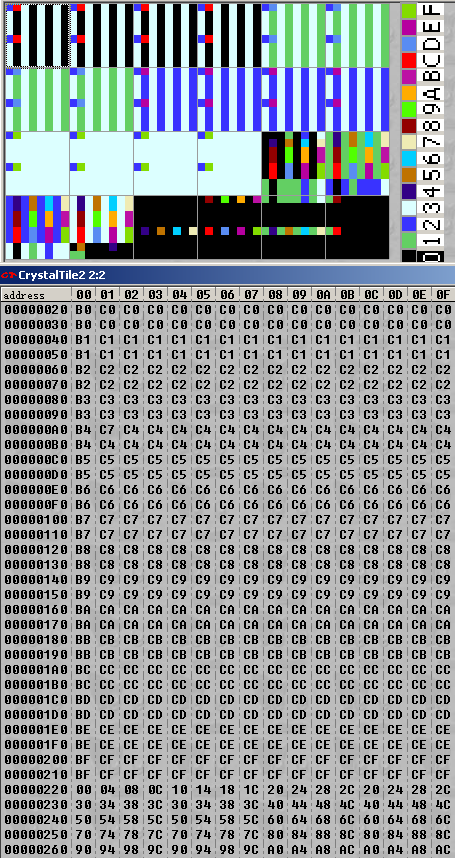
PIC
2.3.6 Bitmap
This will probably be better served after discussion of graphics modes and hardware but know this is not referring to the “bitmap” image format as seen in every basic image editor and most advanced ones, although some modes of it share a lot in common with said format.
The GBA has the ability to eschew tiles and just draw images line by line across the entire screen although it limits what can be done as to do it takes up most of the VRAM and it is not feasible to change it all every frame so extremely few games use it.
In the graphics it is known as modes 3, 4 and 5
3
is a 240x160 (aka the GBA resolution) 16 bit mode where colours are defined there and then (same BGR fashion as the rest of the hardware)
4
is a 240x160 8 bit mode where the full 256 colour palette is used (modes 3 and 5 do not allow transparent colours unlike this) and allows 2 frames to be defined in memory at once.
5
is a 160x128 (less than GBA resolution) mode using the same idea as mode 3 but the lowered size allows two frames to be stored in VRAM.
The DS has a kind of related tile mode where large tiles still composed or palette references like regular tiles can be used and it is quite popular but the DS has a slightly increased VRAM size to manage this better. It also has the ability to hold and manipulate images larger than the resolution in bitmap modes (it comes in handy for some end stage representation of 3d) although again this is better served for a discussion of hardware.
2.3.7 Known formats
Some games have been seen to use known/common formats like GIF, PNG and JPEG with the most prolific being that of the DS Opera browser. With it having to decode them as part of the general operation (what is the web without images after all) meant it could use such formats internally quite happily but other games have certainly been seen to do this as well. This becomes even more common on other more powerful consoles but the DS does have a few formats that Nintendo provides in the SDK that allow for some fairly extensive abilities, more on those in the layout/OAM section.
2.3.8 Crystaltile2 export and import.
Although Crystaltile2 usage is covered in depth later this is a basic operation and should be covered now. Most tile editors are just that and will allow you to edit an image but occasionally you are going to want to not be tied to a pixel by pixel editor and will want to use a more featured editor.
The act of exporting and importing images is easy enough. Although it is quite possible to do without a palette set properly it is best to have one in place else you will have to edit pixels accordingly in your proper image editor (red means blue and such) and much like hex mathematics you can fall foul of this when just making quick changes.
First select the tiles/area you want to edit. The either right click or click the edit pulldown menu
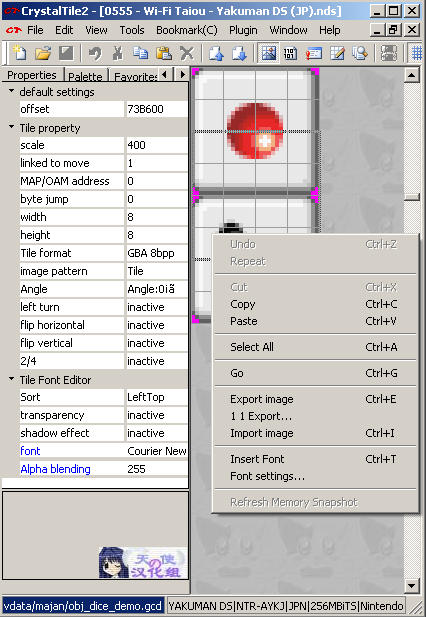
PIC
You can either copy the image out if you have a few small edits but most will instead opt to export it. Crystaltile2 has a few basic options but BMP works for most purposes. Here you can import it into your chosen editor
There is also the second option of a 1:1 export which splits things along the tile lines and allows a sort of regular expression to be formed.
Once in the editor you can edit it accordingly
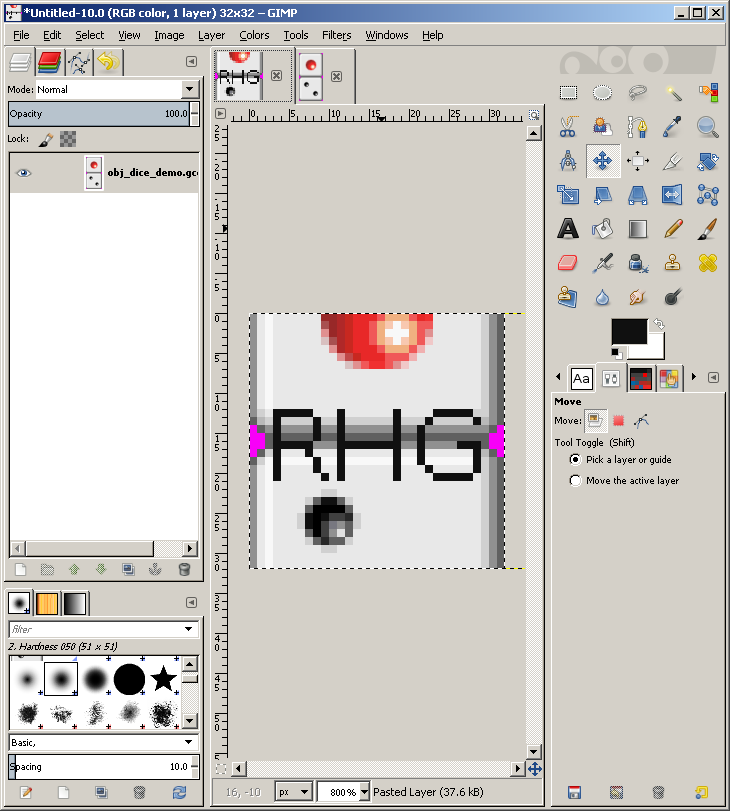
PIC
Right clicking or clicking the edit pulldown menu and pressing import will import the newly saved image back into the editor where you can move it (it will snap to gridlines). Again you can use the copy and paste if you prefer although do remember to merge layers if your editor supports it.
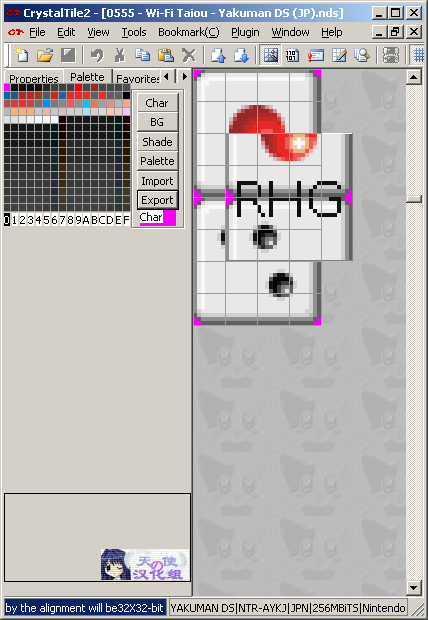
PIC
Move it accordingly and then double click the image to set the image
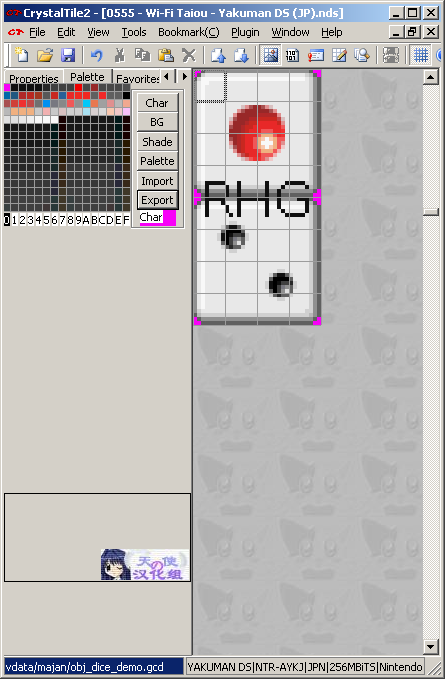
PIC
On palettes If the colour you want is in the image then the dropper is usually sufficient but most tile editors have the option to export palettes to the commonly supported windows palette format; crystaltile2 has it right there in the palette window and BMP has a palette built into the file format (technically optional but crystaltile2 includes it).
2.3.9 Avoiding gradients, AA, lossy compression, noise and such things.
The name of this says it all really and most pixel artists will know this already, however it needs to be mentioned to spare you the hassle of having to redo the whole palette which might not even be viable if the palette is used elsewhere, not to mention if you only have limited colours available it makes sense not to waste them unless you do truly have the option to do so. To this end you should avoid gradients (hopefully one already exists if you need one), anti aliasing options (quite often added in when adding text), resizing (the nearest neighbour algorithm is probably the worst general usage scaling method but it has the benefit of using the colours it had to begin with if you truly need one), noise functions and other things that will add random extra colours to your image (like saving as JPEG, even at “100%”). This means that unlike most image editing you might have done at other points in life you are limited here.
On a different note much like changing palettes can change things elsewhere in the ROM you also have layout to contend with, or worse you face limited memory, which might limit the tiles you can edit but that is the subject of the next section.